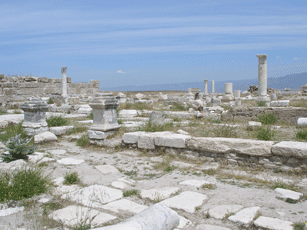CGOM: Where is the True Church?

Laodicea is Composed of Many Ineffective Structures
In its latest update, CGOM (UK)’s James McBride wrote the following:
Where Is ‘the True Church’?
For some it is an all-consuming quest, a life-long pursuit to find it. And what spiritually-aware individual would not want to be a part of that desirable end. Jesus asserted that he would build his church and we need not doubt that it exists somewhere. But where?
No Christian would like to think that his or her own denomination is not so represented. For who would want to belong to the opposite—a ‘false church’!
Yet the choice is virtually infinite, with thousands of options—like some vast spiritual hypermarket, accessible via the internet. You don’t even have to stir from your couch, and somewhere there will be one that takes your fancy.The bottom line, however, is that no one such option is the sole representative of the church that Jesus is building. And that is despite the claims made by an array of self-styled ‘apostles’ and ‘witnesses’ and ‘prophets’.We may, certainly, learn from a charismatic preacher or skilled Bible exponent. (The two, note, are not always the same!) But if he or she claims to be ‘God’s only representative’ or the one who alone ‘has it right’ – you can be sure you are in the presence of a purveyor of spiritual snake oil. Be wary—run!.
Simply, the ‘one true church’ is composed of everyone in whom the holy Spirit is living and acting. That means that the Father and Jesus are residing in and guiding them. And they are scattered worldwide—not solely in a particular denomination.Don’t Jump Ship
Even a superficial analysis of the New Testament makes clear that no church of God was doctrinally perfect. Some even bordered on the heretical, yet were accepted by Jesus (eg Revelation 2-3) as his church.
Now I would like to take this a step further and explain that Jesus actually had the most praise for the churches of Smyrna and Philadelphia in Revelation 2 & 3.
In my opinion, in these latter days, those who wish to be truly faithful will try to be true Philadelphians and support the Living Church of God–the group that now best represents the Philadelphia Church in these end times.
Jesus taught:
22 He who has an ear, let him hear what the Spirit says to the churches (Revelation 3:22).
It is not “jumping ship” to heed Jesus’ warnings to the Churches.
Some articles of related interest may include:
The Churches of Revelation 2 & 3 from 31 A.D. to present: information on all of the seven churches of Revelation 2 & 3.
1. The Ephesus Church Era was predominant from 31 A.D. to circa 135 A.D. The Church of James, Peter, Paul, and John, etc.
2. The Smyrna Church Era was predominant circa 135 A.D. to circa 450 A.D. The Church led by Polycarp, Melito, Polycrates, etc.
3. The Pergamos Church Era was predominant circa 450 A.D. to circa 1050 A.D. An especially persecuted Church.
4. The Thyatira Church Era was predominant circa 1050 A.D. to circa 1600 A.D. The Church during the Inquisition.
5. The Sardis Church Era was predominant circa 1600 A.D. to circa 1933 A.D. Discusses early history of the Seventh Day Baptists, Seventh-day Adventists, and COG-7th Day.
6. The Philadelphia Church Era was predominant circa 1933 A.D. to 1986 A.D. The old Radio Church of God and old Worldwide Church of God, now basically the Living Church of God.
7. The Laodicean Church Era has been predominant circa 1986 A.D. to present. These are non-Philadelphians who mainly descended from the old WCG.
Early Church History: Who Were the Two Major Groups Professed Christ in the Second and Third Centuries? Did you know that many in the second and third centuries felt that there were two major, and separate, professing Christian groups in the second century, but that those in the majority churches tend to now blend the groups together and claim “saints” from both? “Saints” that condemn some of their current beliefs. Who are the two groups?
Hope of Salvation: How the Living Church of God differ from most Protestants How the Living Church of God differs from mainstream/traditional Protestants, is perhaps the question I am asked most by those without a Church of God background.
The Similarities and Dissimilarities between Martin Luther and Herbert W. Armstrong This article clearly shows some of the doctrinal differences between in the two. At this time of doctrinal variety and a tendency by many to accept certain aspects of Protestantism, the article should help clarify why the Living Church of God is NOT Protestant. Do you really know what the Protestant Reformer Martin Luther taught and should you follow his doctrinal example?
What is a True Philadelphian? Many claim to be part of the Philadelphia era of the Church, but is claiming enough? This article has biblical and historical evidence about who really are the Philadelphians.
There are Many COGs: Why Support the Living Church of God? This is an article for those who wish to more easily sort out the different COGs. It really should be a MUST READ for current and former WCG/GCI members or any interested in supporting the faithful church. It also explains a lot of what the COGs are all about.
 |
Tweet |
|